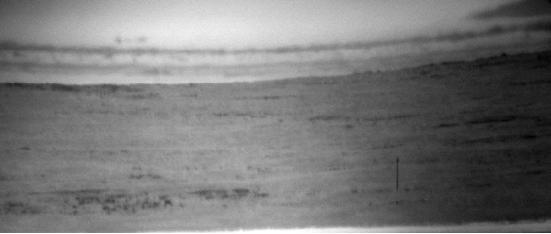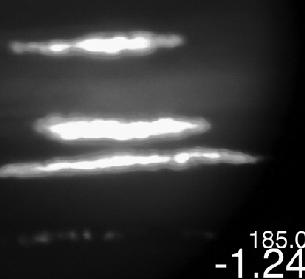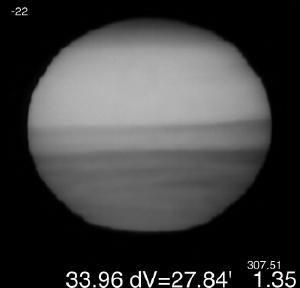|
by
Wayne Davidson

An
Inversion caused
what appears to
be land afar on
a western Arctic
coastal horizon,
really
consisting of
open water, thin
ice and warmer
air aloft. There
are a few clues
which gives away
the mirage: note
the land profile
mimics the
apparent distant
double
‘landscape’.
This is due to
an inversion
hugging the land
horizon at about
the same height
throughout.
Unless a map is
available or one
goes strait into
the direction of
the mirage, one
can easily
assume that
there is a big
island about 50
to 100 miles
away, with also
clouds on top.
This
is not the first
time when Dr
Cook’s diary gets
dissected, but it
will be a first
literally showing
that he couldn’t
have made up his
journal on Arctic
Ocean ice without
actually being
there. Astronomers
like Denis Rawlins,
and Stockwell in
1910, rightfully
questioned the
veracity of Dr
Cook’s claims, as
another astronomer
correctly stated:
extraordinary claims
requires
extraordinary
evidence.
In
this case proof
comes along as
repetition, a key
component of applied
science. Claims
given by Cook must
be repeated,
otherwise they
remain without
justification, a
tenuous place to be.
This essay merely
complements my
previous
verifications on
Doctor Cook’s
North Pole journey.
Sheldon Cook’s
conclusion that
there was nothing
but ice at the Pole
as reported by Dr
Cook in 1908, is
complemented by
actual strange sun
disk observations
that turn out to be
equally true, but
not only that, true
at the location
reported.
In
1908, Dr Cook was no
stranger to Polar
nights, astronomy
nor sextant usage,
but he was
ingrained, along
with every other
explorer of the day,
with sextant
knowledge still
unfamiliar with
certain precepts of
sunset science
discovered not long
ago. It is
informative, and
essential to
understand that
while on the Belgica
in Antarctica in
1898, Dr. Cook and
all the ships crew,
were on deck waiting
for a sign of the
sun after surviving
nearly three months
without it.
They
did not know that it
was already up
several days before.
All were expecting
the sun at a normal
almanac time, when
the sun center is
–0.8 degrees below
the horizon.
Navigation education
was so authoritative
that it forced them
to wait for that
date. Unbeknownst to
them, perhaps except
a lone crew hand,
the sun much likely
showed up, not
exactly round, a
couple of days
before. So for Dr.
Cook’s future,
imbued with
experience and
certainly many
conversations with
Belgica’s
navigator, Dr.
Cook’s knowledge
of astronomy was
still strongly
influenced by
contemporaneous 19th
century science, not
quite at par with
reality.
For
a North Pole
trekker, what better
moment when the
first midnight sun
appears, a time when
there is no sunset
possible. While Dr
Cook was really
heading North, or
some may say while
fabricating that he
was heading North,
lies a trap for
fiction tellers,
inconceivable to
scrutiny in the
earlier part of the
20th century, but
now understood at a
much higher level of
science.
Dr.
Cook’s biggest
flaw, in my opinion,
is the lack of
precision in
specific details,
which has supplied
fodder a plenty for
his past and present
enemies. On previous
issues of this
journal, I have
proven that Cook had
certainly passed 84o
North, not because I
confirmed his
official
observations, but
rather by analyzing
apparently innocent
comments. Those very
same words can
easily sink a person
committing
exploration fraud.
Fortunately, I
started commenting
on Dr Cook’s
diaries while doing
Polar research in
some ways related,
while this work is
still currently in
progress, I found
another piece or so
of the missing
puzzle.
It
is very easy to miss
a point raised by
Dr. Cook as his easy
prose makes one
forget some details.
Those details, very
few words, can in
fact vindicate him
without doubt or
castigate him at the
same level as Peary,
a fraud that need
not be. Alas these
words, treasure for
debunkers and
verifiers, are not
so common.
“Midnight;
north cloudy, but
ice bright; many
hummocks…”
March 28, 1908
This
was written in Dr.
Cook’s diary when
he was about 84 35 N
95 36 W . The sun
was -2.2 degrees
true below the ice
horizon. But it was
bright outside? That
is perfectly what a
faking explorer
would not write.
Despite clouds, in
the North, the ice
was bright, not so
ancient science
would have scoffed
at this statement.
March
29: “Start
early PM. A little
blue in the west;
sun bursts pack
disturbed; hard
traveling, due to
fresh crevasses.
Camp midnight; only
9 miles.”
Sun
Bursts? Those words,
may mean sun
breaking through
clouds, or partially
seen behind clouds.
“Blue in the
west” would be a
fantastic word
sequence, only if he
gave an exact time,
or words, blue is a
key sky colour which
stays even when the
sun is very low. It
would in fact be a
positional
statement. But since
“Early PM” means
perhaps 7 pm, blue
skies were possible
at that time.
On
March 30 1908. Dr.
Cook reports seeing
“Bradley Land”,
which of course,
does not exist. A
prerequisite for
seeing a massive
mirage is the
requirement of some
clear skies, which
happened that day.
Again “Bradley
Land”, many times
irrationally laughed
at as a claim,
sticks out as a
reason for a
traveler actually
being there. Why
would a fraudulent
explorer claim such
a landmass knowing
full well that it
will be disproved in
the future? Some
country would
certainly have been
keen to claim it? A
fictitious
‘Bradley land’,
is not an ideal
fraud spin, it was
rather a mirage,
which of course is
not provable.
84
50 N 95 36 W : “A
low fog persistent;
cannot see shore;
for days we have
expected to see
something W, but
never a clear
horizon. Probably
two islands like
Heiberg, 1800 feet
high, valleys,
mountains, snow N,
table 1000, thin ice
sheet, bright
nights.”
Further
reading Dr Cook’s
journal reveals that
on the next day,
March 31, he
detected several
mirages, but as they
went straight North
towards them, they
of course
disappeared. Those
western Islands once
called “Bradley
land”, estimated
to be 50 miles away
were not in the path
to the pole, they
were not really
explored.
Furthermore, massive
thin ice sheet or
shallow but trapped
warmer air are
required to have
such an illusion.
Dr
Cook reported thin
ice in the direction
of ‘Bradley
Land’. Closing the
case once and for
all about a
‘Bradley Land’
fraud attempt would
require further
research into who
was responsible for
including that ’
Bradley land’
picture in the first
versions of Cook’s
My Attainment of
the Pole, which
may not have
necessarily been
under full control
of its author.
March
30 was the day when
the midnight sun was
supposed to rise
according to old
ways of navigation.
It seems strange, Dr
Cook did not write
about this day in
the same terms as on
the Belgica 10 years
before. There is no
anticipation, just a
few scant notes. It
is the way of the
old polar explorer,
devoid of the luxury
of time, not really
calculating position
every day, eager to
reach his
destination,
foregoing such
apparent trivial
things, exhaustion
exceeds curiosity,
the only goal is the
pole…
Another
big moment in
Cook’s diary,
which falls flat on
account of clouds,
is April 1, 1908:
There is no more
darkness at night.
At
this point on, it
can be said that the
midnight sun has
started, but in
fact, it likely has
on March 28, from
that date on, Dr
Cook has reported
bright nights ,
suggesting very much
so that he was at
the latitude he
claimed, but on the
28th the sun was
likely a very thin
line, deplete of
great luminescence.
Clouds negated such
a sighting at
midnight, until the
sun was really seen
at midnight on April
7 above the ever so
present low layer of
ice crystals, fog
and clouds. However,
prior to April 1,
the question of
darkness, interested
me a great deal, but
clouds in the
various opacities
and coverage,
distort the darkness
factor greatly.
 |
 |
| This
is the sun,
yes the sun.
Appearing at
sunrise
after the
long night,
as seen
through low
clouds.
With eyes
only, the
most
remarkable
feature is
the top
sliver,
which
constantly
changed size
while
flashing in
blue-green
bursts
lasting a
few seconds.
The digital
camera
couldn't
pick up this
colour. |
Sometimes
the great
luminary was
drawn out
into an
egg-shaped
elongation
with
horizontal
lines of
color drawn
through it. |
The
most crucial dates
on Cook’s journey
to the Pole were
said to be marred by
clouds, so it would
have been extremely
easy to pick up
fraudulent writing
only if he declared
exactly when the sun
rose above a clear
horizon. For a
verifier this is
frustrating. But the
said brightness at
the latitudes
coincide very well
with present
knowledge about
Polar brightness
during twilight. But
it is not enough to
declare Cook being
at the locations he
claims to be. His
book, following some
chronology gives
more details about
sun shapes and
colors:
The
night of April 7 was
made notable by the
swing of the sun at
midnight, above the
usual obscuring
mist, behind which
it had, during
previous days, sunk
with its night dip
of splendor. For a
number of nights it
made grim faces at
us in its setting. A
tantalizing mist,
drawn as a curtain
over the northern
sea at midnight, had
afforded curious
advantages for
celestial staging.
We were unable to
determine sharply
the advent of the
midnight sun, but
the colored cloud
and haze into which
it nightly sank
produced a
spectacular play
which interested us
immensely. Sometimes
the great luminary
was drawn out into
an egg-shaped
elongation with
horizontal lines of
color drawn through
it.
Cook
wrote, “I pictured
it as some splendid
fire colored lantern
flung from the
window of Heaven.
Again, it was
pressed into a basin
flaming with magical
fires, burning
behind a mystic
curtain of
opalescent frosts.
Blue at other times,
it appeared like a
huge vase of
luminous crystal,
such as might be
evoked by the weird
genii of the Orient,
from which it
required very little
imagination to see
purple, violet,
crimson and
multi-colored
flowers springing
beauteously into the
sky. These changes
took place quickly,
as by magic.”
The
descriptions given
by Dr. Cook are
easily repeatable
with respect to
cloud effects. The
blue sun, must be
the green flash, a
low, very distorted
blue green sun,
which can happen in
spontaneous bursts.
Further
breakdown of this
paragraph is not so
difficult, of course
since exact
notations were
swapped for the need
to preserve heat,
and surviving on
meager rations,
relegating writing
in sub-freezing
conditions not
essential. This
paragraph was not
necessarily a piece
of poetry about sun
disks shaped like
pottery. One can
match some of these
words with his
diary. Of particular
interest is April 3:
“Night
bright; sun at
midnight under cloud
and haze”
The
sun going down in
clouds can be seen
as the following,
taken in the Polar
region 96 years and
13 days later:
On the night of
April 3, the sun
elevation at
midnight as seen by
Cook’s expedition
was about the same
as the picture at
left. The
description given by
Cook is a perfect
match. The odds in
making up this sun
lantern story is
extremely remote. A
flat bottom sun at
such precise and
relatively high
elevation was
totally unknown
then.
A
good work of fiction
cannot really match
reality, as reality
is most times
weirder than
fiction. To make up
such a story, would
mean a thorough
understanding of sun
disk transformations
beyond all that was
known at that time.
This sun lantern is
a piece of a puzzle
which fits with a
grander image of the
truth. He had to be
there to have seen
it. On Midnight
April 3,1908 Dr Cook
was at 85 30 North.
References:
Cook,
Frederick A. Through
the First Antarctic
Night. Reprint
edition 1998, pp
283-284; 187-188
Cook,
Frederick A. My
Attainment of the
Pole. Reprint
edition 2001,
Appendix, field
notes pp 574-578
Hall,
Thomas F. Has the
North Pole Been
Discovered?
Boston: Badger Co,
1919, pp 249-255;
411-433; 479-489;
517-529
Foundation
for the Promotion of
the Art of
Navigation, Robert
E. Peary at the Pole,
1989, pp 24-25
Pictures:
Wayne Davidson,
Resolute Bay,
Nunavut
|